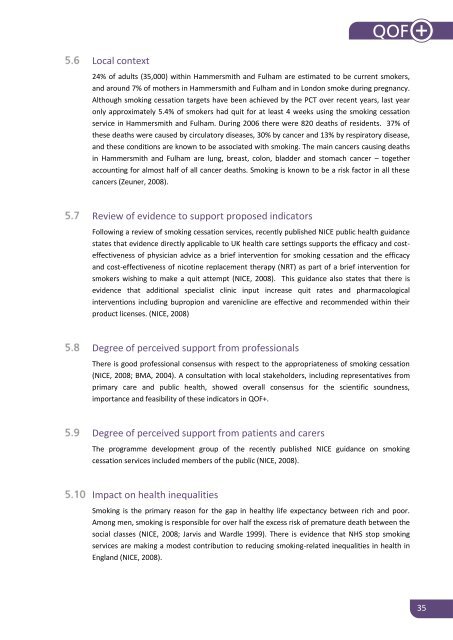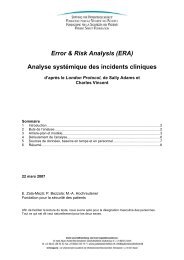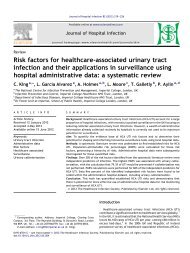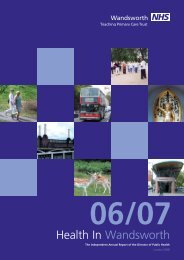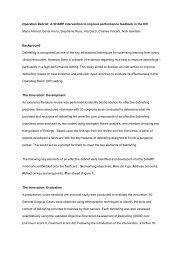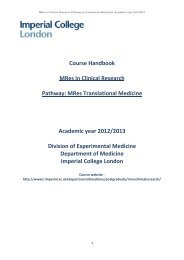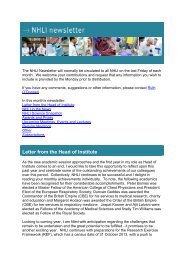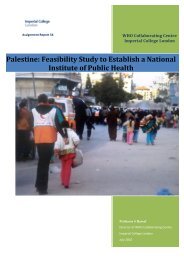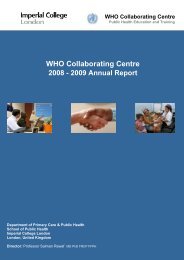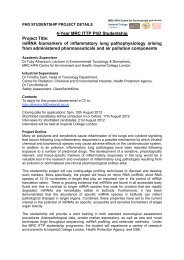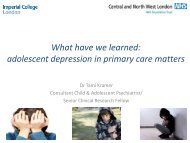QOF Plus Year 1 - Imperial College London
QOF Plus Year 1 - Imperial College London
QOF Plus Year 1 - Imperial College London
You also want an ePaper? Increase the reach of your titles
YUMPU automatically turns print PDFs into web optimized ePapers that Google loves.
Local context24% of adults (35,000) within Hammersmith and Fulham are estimated to be current smokers,and around 7% of mothers in Hammersmith and Fulham and in <strong>London</strong> smoke during pregnancy.Although smoking cessation targets have been achieved by the PCT over recent years, last yearonly approximately 5.4% of smokers had quit for at least 4 weeks using the smoking cessationservice in Hammersmith and Fulham. During 2006 there were 820 deaths of residents. 37% ofthese deaths were caused by circulatory diseases, 30% by cancer and 13% by respiratory disease,and these conditions are known to be associated with smoking. The main cancers causing deathsin Hammersmith and Fulham are lung, breast, colon, bladder and stomach cancer – togetheraccounting for almost half of all cancer deaths. Smoking is known to be a risk factor in all thesecancers (Zeuner, 2008).Review of evidence to support proposed indicatorsFollowing a review of smoking cessation services, recently published NICE public health guidancestates that evidence directly applicable to UK health care settings supports the efficacy and costeffectivenessof physician advice as a brief intervention for smoking cessation and the efficacyand cost-effectiveness of nicotine replacement therapy (NRT) as part of a brief intervention forsmokers wishing to make a quit attempt (NICE, 2008). This guidance also states that there isevidence that additional specialist clinic input increase quit rates and pharmacologicalinterventions including bupropion and varenicline are effective and recommended within theirproduct licenses. (NICE, 2008)Degree of perceived support from professionalsThere is good professional consensus with respect to the appropriateness of smoking cessation(NICE, 2008; BMA, 2004). A consultation with local stakeholders, including representatives fromprimary care and public health, showed overall consensus for the scientific soundness,importance and feasibility of these indicators in <strong>QOF</strong>+.Degree of perceived support from patients and carersThe programme development group of the recently published NICE guidance on smokingcessation services included members of the public (NICE, 2008).Impact on health inequalitiesSmoking is the primary reason for the gap in healthy life expectancy between rich and poor.Among men, smoking is responsible for over half the excess risk of premature death between thesocial classes (NICE, 2008; Jarvis and Wardle 1999). There is evidence that NHS stop smokingservices are making a modest contribution to reducing smoking-related inequalities in health inEngland (NICE, 2008).35


